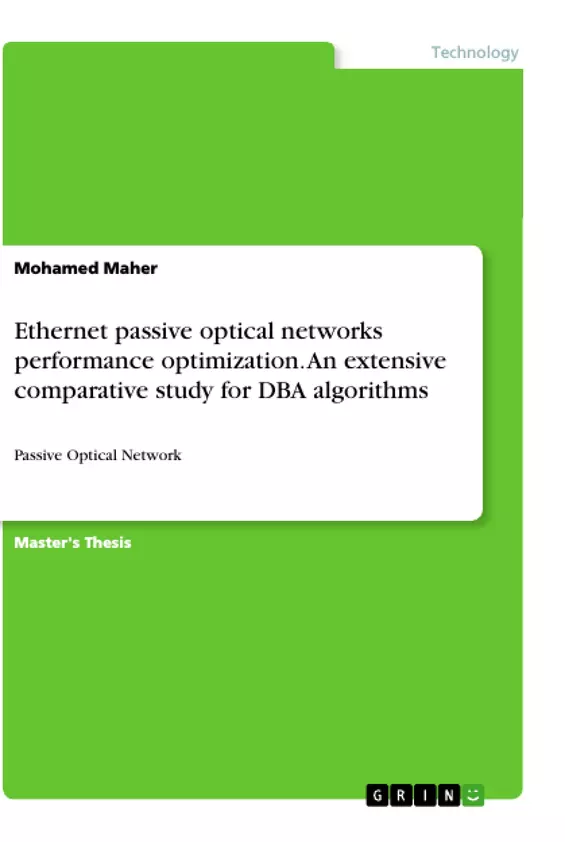This thesis provides a detailed comparison and a classification study for a large number of DBA algorithms with respect to time delay and throughput as performance indicators. The study shows that IPACT WITH CBR, UDBA, IPACT with two stages and CPBA are the optimum DBA algorithms regarding both time delay and throughput at highly loaded scenarios.
Dynamic bandwidth allocation in Ethernet passive optical networks (EPON) presents a key issue for providing efficient and fair utilization of the EPON upstream bandwidth while supporting the quality of service QoS requirements of different traffic classes. Rare literatures have addressed a qualitative and quantitative comparison of large numbers of DBA algorithms based on their performance indicators. These algorithms are enrolled in a parametric optimization process targeting performance enhancement at highly loaded scenarios this increasing upstream line rates, changing distance between the OLT (Optical Line Terminal) and ONU (Optical Network Unit), increasing size of an Ethernet packet and changing maximum cycle time to 1 ms and altering guard time value). This process reduces time delay around 3.5% for IPACT WITH CBR, 1.725% for UDBA, 1.167% for IPACT with two stages and (1.167% for CPBA. Also, the optimization increases the throughput by 1.3% for IPACT WITH CBR, 1.795% in UDBA, 2.5% for IPACT with two stages and 1.684% for CPBA.
Inhaltsverzeichnis (Table of Contents)
- CHAPTER 1
- INTRODUCTION
- History
- Objective of Thesis
- Organization of Thesis
- CHAPTER 2 BACKGROUND AND LITERATURE REVIEW
- Introduction
- Traffic Growth
- Evolution of the “First Mile”
- Next-Generation Access Network
- Overview of PON Technologies
- Optical Splitters/Combiners
- PON Topologies
- WDM vs. TDM PONS
- Burst-Mode Transceivers
- Ethernet PON (EPON) Access Network
- Why Ethernet?
- Principle of Operation Ethernet PON
- BANDWIDTH ALLOCATION
- DBA METHODS
- DBA Algorithms without QoS Support
- DBA Algorithms with QoS Support
- DBA Algorithms with QoS Support locally
- DBA algorithms with QoS support globally (universally)
- DBA METHODS
- CHAPTER 3
- BASIC MODEL AND ANALYSIS
- Introduction
- Time Delay
- Throughputs
- Basic Model
- Mathematical model
- Arishtat Limited Service IPACT-FSD-SLA
- CDBA-IPACT
- CDBA Principle
- e-DBA n-DBA
- EBDBA-YDBA-SDBA-ADBA
- CPBA-IPACT with two stages- IPACT with CBR credit
- TLBA-Two Stage Queue
- IFLDBA-BP
- UDBA-MSARF-CPBA SLA
- CHAPTER 4
- RESULTS AND DISCUSSIONS
- Introduction
- Simulation
- Throughput Performance
- Time delay performance
- Selection of optimum DBA algorithms
- Optimization Process
- CHAPTER 5 CONCLUSION AND FUTURE WORK
- Introduction
- Conclusion
- Future Work
Zielsetzung und Themenschwerpunkte (Objectives and Key Themes)
This thesis aims to provide a detailed comparison and classification study for a large number of Dynamic Bandwidth Allocation (DBA) algorithms in Ethernet Passive Optical Networks (EPON). The study focuses on evaluating the performance of these algorithms based on time delay and throughput, two key performance indicators.
- Comparative analysis of various DBA algorithms for EPON performance optimization.
- Evaluation of DBA algorithms based on time delay and throughput performance.
- Identification of optimum DBA algorithms for highly loaded scenarios.
- Parametric optimization of selected DBA algorithms for performance enhancement.
- Contributions to the understanding of efficient bandwidth allocation strategies in EPON.
Zusammenfassung der Kapitel (Chapter Summaries)
Chapter 1: Introduction This chapter introduces the concept of Dynamic Bandwidth Allocation (DBA) in EPON and highlights the significance of this research. It outlines the history of EPON technology, the objectives of this thesis, and its organization.
Chapter 2: Background and Literature Review This chapter provides a comprehensive overview of EPON technology and existing research on DBA algorithms. It covers key topics such as traffic growth, the evolution of access networks, PON technologies, and the principles of operation for EPON systems. It also delves into various DBA methods, including algorithms without QoS support and those with QoS support, both locally and globally.
Chapter 3: Basic Model and Analysis This chapter presents the fundamental models used for analyzing the performance of DBA algorithms. It describes the mathematical model, time delay, throughput, and various DBA algorithms, including IPACT-FSD-SLA, CDBA-IPACT, e-DBA, n-DBA, EBDBA-YDBA-SDBA-ADBA, CPBA, IPACT with two stages, IPACT with CBR credit, TLBA, Two Stage Queue, IFLDBA-BP, UDBA, MSARF, and CPBA SLA.
Chapter 4: Results and Discussions This chapter focuses on the results of simulations and analyses conducted on different DBA algorithms. It examines throughput and time delay performance for each algorithm, identifies optimal algorithms for highly loaded scenarios, and explores optimization processes for performance enhancement.
Schlüsselwörter (Keywords)
This research focuses on the optimization of EPON performance using Dynamic Bandwidth Allocation (DBA) algorithms. Key terms and concepts include time delay, throughput, QoS (Quality of Service), EPON (Ethernet Passive Optical Network), OLT (Optical Line Terminal), ONU (Optical Network Unit), and various DBA algorithms such as IPACT, UDBA, CPBA, and others.
- Quote paper
- Mohamed Maher (Author), 2021, Ethernet passive optical networks performance optimization. An extensive comparative study for DBA algorithms, Munich, GRIN Verlag, https://www.grin.com/document/1066406



